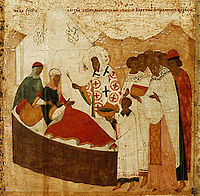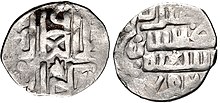| Jani Beg | |
|---|---|
| Khan | |
 Jani Beg on the 1375 Catalan Atlas, with his flag ( Jani Beg on the 1375 Catalan Atlas, with his flag ( | |
| Khan of the Golden Horde Western Half (Blue Horde) | |
| Reign | 1342–1357 |
| Predecessor | Tini Beg |
| Successor | Berdi Beg |
| Died | 1357 Sarai |
| Issue | Berdi Beg and others |
| House | Borjigin |
| Dynasty | Golden Horde |
| Father | Öz Beg Khan |
| Mother | Taydula Khatun |
| Religion | Islam |
Jani Beg (Persian: جانی بیگ, Turki/Kypchak: جانی بک; died 1357), also known as Janibek Khan, was Khan of the Golden Horde from 1342 until his death in 1357. He succeeded his father Öz Beg Khan.
Reign
With the support of his mother Taydula Khatun, Jani Beg made himself khan after eliminating his older brother and rival Tini Beg at Saray-Jük in 1342; he had already killed another ambitious brother, Khiḍr Beg. He is known to have actively interfered in the affairs of the Russian principalities and of Lithuania. The grand princes of Moscow, Simeon and Ivan II, were under constant political and military pressure from Jani Beg.
Jani Beg commanded a massive Crimean Tatar force that attacked the Crimean port city of Kaffa, then a Genoese colony, in 1343. The siege was lifted by an Italian relief force in February. In 1345, Jani Beg again besieged Kaffa; however, his assault was again unsuccessful due to an outbreak of plague among his troops. Jani Beg's army catapulted infected corpses into Kaffa in an attempt to use the plague to weaken the defenders. Infected Genoese sailors subsequently sailed from Kaffa to Genoa, Messina, and Constantinople, introducing the Black Death into Europe. The story involving the catapult has been disputed. It is originally based on Gabriel de Mussis of Piacenza in Italy, who wrote about the plague in 1348. It is more likely that rats carrying plague-infested fleas went from the Jani Beg's camp to the city and thereby infected the Genoese.

In 1356, Jani Beg conquered the city of Tabriz, installing his own governor. He also asserted Jochid dominance over the Chagatai Khanate, attempting to unite the three khanates of the Mongol Empire. After accepting surrender from Shaikh Uvais, Jani Beg boasted that three ulus (districts/nations) of the Mongol Empire were under his control. Soon after this, he faced an uprising in Tabriz resulting in the rise to power of the Jalayirid dynasty, an offshoot of Ilkhanate, and ultimately in the death of the Khan.
The Chudov Monastery in Moscow, founded at about the time of Jani Beg's fall by Metropolitan Aleksii and Sergii of Radonezh, was built on land that according to legend was granted to Aleksii by the Khan as thanks for the miraculous curing of his mother Taydula by the former.
The reign of Jani Beg was marked by the first signs of the feudal strife which would eventually contribute to the demise of the Golden Horde. Jani Beg's assassination in 1357 opened a quarter-century of political turmoil within the Golden Horde. Twenty-five khans took power between 1357 and 1378.
-
 Metropolitan Alexis Healing the Tatar Queen Taidula from Blindness while Janibeg Looks on, Yakov Kapkov (1816-54)
Metropolitan Alexis Healing the Tatar Queen Taidula from Blindness while Janibeg Looks on, Yakov Kapkov (1816-54)
-
 Metropolitan Alexis healing Jani Beg's mother from blindness (detail from a 15th- or 16th-century painting by Dionisius)
Metropolitan Alexis healing Jani Beg's mother from blindness (detail from a 15th- or 16th-century painting by Dionisius)
-
 The murder of Jani Beg by Berdi Beg (miniature from a volume of the Illustrated Chronicle of Ivan the Terrible)
The murder of Jani Beg by Berdi Beg (miniature from a volume of the Illustrated Chronicle of Ivan the Terrible)
Catalan Atlas (1375)

 .
.Jani Beg appears in the 1375 Catalan Atlas: the Mongol polity of the Golden Horde is accurately depicted north of the Caspian Sea. Jani Beg has been identified in this representation, being mentioned as "Jambech senyor de Sarra", and the flag of the Golden Horde also appears (![]() ). The caption to the right of his depiction reads:
). The caption to the right of his depiction reads:
Here resides the emperor of this northern region whose empire starts in the province of Bulgaria and ends at the city of Organcio. The sovereign is named Jambech, Lord of the Sarra.
The symbolism of the Golden Horde flag depicted by the Catalan Atlas (![]() ) is fairly similar to the type of tamgha symbols (such as
) is fairly similar to the type of tamgha symbols (such as ![]() ) actually found on the coinage of the Golden Horde. Such symbols were used until the time of Jani Beg, but essentially disappear thereafter.
) actually found on the coinage of the Golden Horde. Such symbols were used until the time of Jani Beg, but essentially disappear thereafter.
Family


Jani Beg had a number of sons, only one of whom, Berdi Beg, reigned after him but who proceeded to eliminate his brothers. Two or three more khans appear to have claimed to be Jani Beg's sons and are sometimes treated as such by modern scholars.
- Berdi Beg (r. 1357–1359)
- (pretended?) Qulpa (r. 1359–1360)
- (pretended?) Nawruz Beg (r. 1360)
- (pretended?) Kildi Beg (r. 1361–1362)
- a daughter, Shakar Beg, married Aq Sufi Qongirat, the prince of the Sufi dynasty of Khwarezm. Their daughter Khanzada Begum later married into the Timurid dynasty.
Genealogy
See also: Family tree of Genghis Khan- Genghis Khan
- Jochi
- Batu Khan
- Toqoqan
- Mengu-Timur
- Toghrilcha
- Uzbeg Khan
- Jani Beg
- Uzbeg Khan
- Toghrilcha
- Mengu-Timur
- Toqoqan
- Batu Khan
- Jochi
In popular culture
The 2012 Russian film The Horde is set during the reign of Jani Beg and is a highly fictionalised narrative of how Aleksii healed Taidula from blindness.
See also
References
- Buell, Paul D.; Fiaschetti, Francesca (6 April 2018). Historical Dictionary of the Mongol World Empire. Rowman & Littlefield. p. 67. ISBN 978-1-5381-1137-6.
- "How the Plague Spread to Italy". Brown University. March 12, 2010.
But then, in 1347, to the Italians' delight, their opponents began to die off at an alarming rate - Janibeg's army was overcome by the Plague. Janibeg had no choice but to call off his siege, but not until he performed one last act of warfare against Genoa. Using the catapults designed to throw boulders and fireballs over the walls of fortified cities like Kaffa, Janibeg launched the Plague infested corpses of his dead men into the city. The Italians quickly dumped these bodies back into the sea, but the damage was done. Due to the squalid conditions forced upon Kaffa by the siege, it was ripe for the quick desolation of the Plague.
- O. Benedictow: The Black Death 1346–1353: The Complete History. Woodbridge 2006.
- Matthew J. Broughton Catapulted Death: Can a Flying Corpse Distribute the Plague? Retrieved: 30 June 2022.
- Massing, Jean Michel; Albuquerque, Luís de; Brown, Jonathan; González, J. J. Martín (1 January 1991). Circa 1492: Art in the Age of Exploration. Yale University Press. p. 29. ISBN 978-0-300-05167-4.
- Massing, Jean Michel; Albuquerque, Luís de; Brown, Jonathan; González, J. J. Martín (1 January 1991). Circa 1492: Art in the Age of Exploration. Yale University Press. p. 29. ISBN 978-0-300-05167-4.
- "The Cresques Project - Panel V". www.cresquesproject.net.
-
 Coinage of Mengu-Timur. Bulghar mint. Dated AH 672 or 3 (AD 1273-1275)
Coinage of Mengu-Timur. Bulghar mint. Dated AH 672 or 3 (AD 1273-1275)
- Asiatische Forschungen. O. Harrassowitz. 1982. p. 184. ISBN 978-3-447-02273-6.
The tamga ( a sign of ownership or of belonging to a clan ) drawn on the flag can be seen on coins minted in Bulgar and Bilyar at the time of the early Golden Horde. (...) Besides the Catalan atlas of 1375 there is also a 50 x123 cm Catalan map preserved in Paris.
- Fedorov-Davydov, German A. (2003). "The Monetary System of The Golden Horde" (PDF). Paleograph Press: 349.
Tamga in the form of a two-pointed prong was retained on the coins minted in Bolgar, Mokhsha and the Crimea up until the reign of Janibek, marking the disappearance of this image for the rest of the 14th century.
- E.g., Buell 2003: 76; contrast Gaev 2002: 18-19, and Počekaev 2010: 122, 124.
- Martin Bernard Dickson, Michel M. Mazzaoui, Vera Basch Moreen, Intellectual studies on Islam: essays written in honor of Martin B. Dickson (1990), p. 113.
Bibliography
- Buell, Paul D.; Fiaschetti, Francesca (2018). Historical Dictionary of the Mongol World Empire (2nd ed.). Lanham: Rowman & Littlefield. ISBN 978-1-5381-1137-6.
- Gaev, A. G. "Genealogii͡a i khronologii͡a Dzhuchidov" [Genealogy and chronology of the Jochids]. Drevnosti Povolzhʹi͡a i drugikh regionov. Vypusk IV. Numizmaticheskiĭ sbornik. T. 3 (in Russian). Nizhny Novgorod: IPR Informelektro. pp. 9–55. ISBN 5-7801-0222-8.
- Horrox, Rosemary, ed. (15 October 1994). The Black Death. Manchester University Press. ISBN 9780719034985.
- Kołodziejczyk, Dariusz (2011). The Crimean Khanate and Poland-Lithuania: International Diplomacy on the European Periphery (15th-18th Century). A Study of Peace Treaties Followed by Annotated Documents. Leiden: Brill. ISBN 9789004191907. Archived from the original on 30 June 2017. Retrieved 23 January 2016.
- David Morgan, The Mongols
- Pochekaev, R. Yu. (2010). T͡Sari ordynskie. Biografii khanov i praviteleĭ Zolotoĭ Ordy. Saint Petersburg: Yevraziya.
| Preceded byTini Beg | Khan of the Blue Horde and Golden Horde 1342–1357 |
Succeeded byBerdi Beg |
| Mongol Empire | |||||||||||
|---|---|---|---|---|---|---|---|---|---|---|---|
| |||||||||||
| |||||||||||
| |||||||||||
| Timeline of the Mongol Empire | |||||||||||